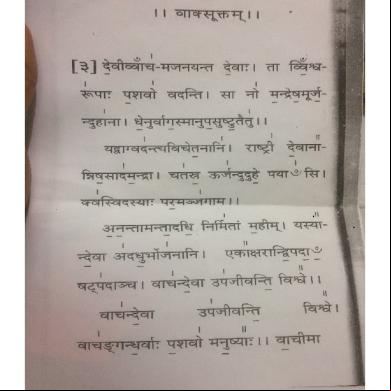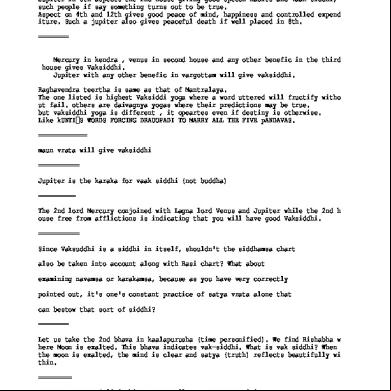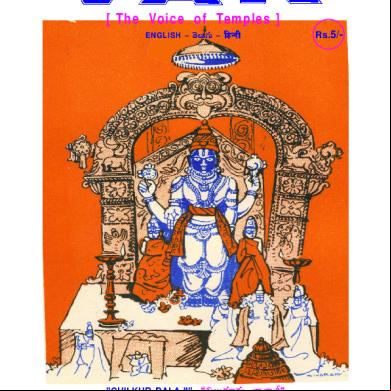Sahasrakshara Vak t6927
This document was ed by and they confirmed that they have the permission to share it. If you are author or own the copyright of this book, please report to us by using this report form. Report 3b7i
Overview 3e4r5l
& View Sahasrakshara Vak as PDF for free.
More details w3441
- Words: 792
- Pages: 2
Sahasrakshara Vak vAgvAdinyai namaH The concepts of devaM manaH and sahasrAkSharA vAk i.e. The Supreme as the Illumined Mind and the Speech of Thousand Syllables, is a lofty contribution of the Seer dIrghatamas, obviously a pseudonym given to a thinker who represents grappling with the long darkness of the mystery of creation. The best approach that one can adopt for a rational understanding of the shabdas in Rg Vedic mantras such as the ones in asya vAmIya sukta, has been described as parokSha or the esoteric way - paroSkapriyA iva hi devA bhavanti pratyakShyadviShaH. For example, akShara is semantically derived from akShaya, the inexhaustible, agni from agri, being the primeval principle of creation (agrirhavai tamagnirityAchakShate parokSham]. By meanings of hundreds of such semantic etymologies, one is led to the inner meaning of words. The other technique is of symbolism pure and simple, known as nidAna; e.g., the cow as the symbol of Motherhood or creative generation or of infinite nature or of vAk for which there is ample pramANa in the Rig Veda itself: dhenur vAg asmAn upa suShTutaitu etc. Thus, vAk as speech is only simply meaning of the word, but this basic meaning is amplified in numerous ways in the brAhmaNas. For example, vAk as prajApati, as prANa pati, as cow, as sarasvatI, as ocean, as sAhasrI, as sAvitrI, as suparNI the great bird, as shatapadI, as pathyA svasti, as intellect or dhiShaNA, as dyauH, as antarikSha, as vishvaAmitra, as sarvam bheShajam, as retas and as devanAm manotA. These various interpretations of vAk , if ignored as arthavAda, is simply indicative of the ignorance of such an inquirer, of the essential elements of vAgvidyA. While the asya vAmIya hymn is centered on the multifold aspect of the supreme vAk, a summary of the cosmogonical principles propounded by the sUkta is presented in a text-book from Benares Hindu University: 1. It inculcates the Trinitarian Basis of Creation that the whole world is constituted of a triadic pattern. There are many formulations of the threefold constituent, all under the general name of Three Brothers. The most important of them all is the statement in of mind, life and matter, corresponding to manas, prANa and vAk. [Mantras 1 to 4] 2. The principle of the two fundamental entities co-existing and originating from a common source, that is the Immortal and the Mortal, which in Modern would mean the twin Principles of energy and Matter, corresponding to the worlds of Heaven and Earth. [Mantras 30 and 38] 3. The formulation that the whole world of Time-Space relata is governed by the Wheel-principle or a rhythmic, cyclic motion about which science and philosophy are in agreement with respect to their explanations of cosmic dymanism. [ Mantras 2, 3, 11, 12, 13, 14 and 8] 4. The principle that the supreme characteristic of Mother Nature is the quality of infinite progenition and productivity, an idea expressed through the symbolism of the Universal Cow, Calf, Milk, Cowherd etc. Wherever nature's provision for Life is processed, that is symbolized as the milk-pot of which each body is an exemplar on the three levels of men, animals and plants. Even the cosmos is conceived of as a Boiler maintained at a certain degree of temperature i.e. abhiddha gharma. [Mantra 26] 5. The most important principle about the manifestation of Life (jIva) in Matter, or the emergence of the Baphometic Fire called prANAgni from the Universal Ocean of the First Cause. 6. The principle of Animus and Anima, half-male and half-female, i.e. the ardhanArIshvara doctrine as the rootcause of biological manifestation [Mantras 16, 33] 7. Sun as the center of an orderly cosmic system, and the whole world as a garment enveloping the center, conceived of a Cloth woven with seven threads symbolizing the warp and woof of Mind, Life and the five elements of Matter. [Mantra 5] 8. The principle of the Universal and the Individual and of their inter-relationship. [Mantras 34, 35] 9. The principle that whatever exists in the manifest cosmos also exists in the unmanifest source, call it by any name we will, so that the potential and the kinetic, the cause and the effect vie with each other and are mutually energizing.
10. The doctrine of the Logos or vAk, transcendent and infinite as the sahasrAkSharA, and finite as Speech in the form of uttered syllables. It includes within its fold the elaborate doctrine of the cosmos as the Thought or Mind of its creator, and is the same as the statement that the Creation is Thought-construct of its Maker. The world of ideas is real and descends to the level of manifest concrete world. As a side note, bhagamAlinI samhitA, quoted twice by bhAskararAya, prescribes homa with this sUkta to please vAgvAdinI.
10. The doctrine of the Logos or vAk, transcendent and infinite as the sahasrAkSharA, and finite as Speech in the form of uttered syllables. It includes within its fold the elaborate doctrine of the cosmos as the Thought or Mind of its creator, and is the same as the statement that the Creation is Thought-construct of its Maker. The world of ideas is real and descends to the level of manifest concrete world. As a side note, bhagamAlinI samhitA, quoted twice by bhAskararAya, prescribes homa with this sUkta to please vAgvAdinI.










